The Legendary 300 Weatherby Hunting Cartridge was built for Big Game….Africa has Big Game
Thomas Weiland once said, “…only accurate rifles are interesting.” It’s true, accurate rifles are really interesting. My Weatherby will rival any rifle 3x the price. You don’t have to be a rich person to own a high performance rifle. My Weatherby Vanguard is proof-positive of this fact. This rifle shoots 1/2″ MOA groups with hunting loads. It is a Sub- MOA rifle out of the box. With a few enhancements this rifle is down right awesome. Thomas Weiland would be fascinated!
For those of us that covet rifles that deliver extreme performance, the Weatherby brand is well respected. Roy Weatherby introduced the 300 Weatherby cartridge in 1956. He tested the cartridge on North American big game like Elk and later in Africa on Plains Game. In this article I will share with you some of my most memorable moments shooting the 300 Weatherby.
Best hunting Rifle Set up- 300 Weatherby
Elk hunting is synonymous with the 300 Weatherby cartridge. When considering an Elk rifle, I purchased a Weatherby Vanguard rifle chambered in 300 Weatherby. The Vanguard is an entry level production rifle. I purchased the Vanguard (Weatherby’s entry level model) for a modest $650.00 (back in 2010). I did have some modifications made at the Weatherby custom shop. I had them install a new trigger and muzzle break. I also had them laser etch my name on the bolt.
The rifle is topped with a Leupold VX-3 variable power up to 14x zoom. I had the ballistic turret calibrated for the Barnes 180 Grain TSX bullet. This scope magnification range offers the most versatility to be able to make a good placed shot at many different distances.

Hand loading the 300 Weatherby
Let’s be frank, for those that shoot factory ammo, you are only tapping into a small fraction of the performance. The ‘old timers’ know what Weatherby’s can do! Experienced hand-loaders get excited about the possibilities of a high capacity case matched with a high performance hunting bullet. Once a rifle is matched with the perfect bullet weight and muzzle velocity, things really get interesting! Perfecting this combination in your rifle can be a tedious endeavor but it is absolutely worthwhiled.
I loaded a Barnes 180 Grain TSX bullet to a velocity of 2,900 feet per second. My load is very specific I used H4831 SC because it is not temperature sensitive. I also produced ignition with a standard deviation less that 20 feet per second in a 5-shot test volley. You may also want to consider H4350 for similar results.
The 300 Weatherby can be much faster, up to 3,200 feet per second. However, at faster velocities, I was not able to get the 180 grain bullet to stabilized and reach sub-MOA accuracy (my personal standard 1″ MOA or better at 100 yards). At long range, stability trumps speed.
At 2,900 FS, the 180 grain bullets produced sub-MOA groups. This bullet and caliber combination produces very impress knock down performance on heavy game animals. The bullets are also lead free so no need to worry about lead exposure in your meat.
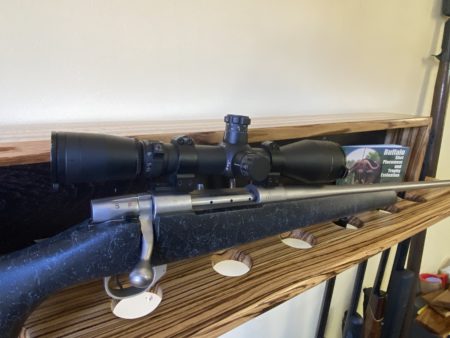
Hunting Africa with 300 Weatherby
When I purchased this rifle, I never imagined that it would travel to Africa with me. It turned out to be a great choice in both rifle caliber and rifle configuration. African hunting offers a wide range of terrain.
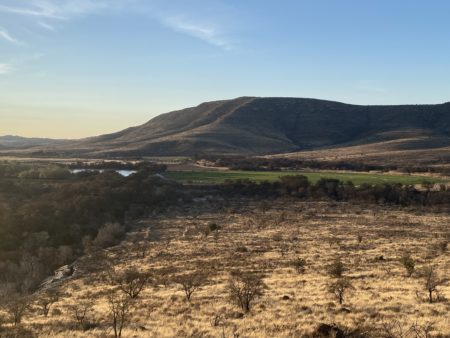
In many cases wide open prairies and open mountain terrain. The animals that live there are also heavy on the hoof. Mature Sables weight 400+ pounds and so do wildebeests!
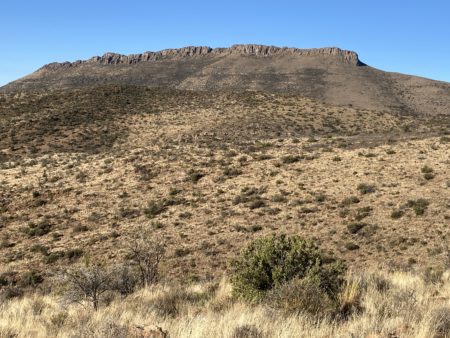
Mountain Zebra are also found in the highlands. These animals can see you coming from miles away. Most animals have a safety zone of approximately 400-500 yards. The 300 Weatherby can close that gap and be the difference between a trophy of a lifetime or a disappointing shot spanking the dirt.
Longest Shot on Game Animals
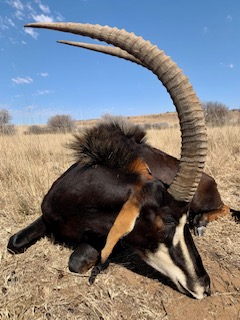
Sable at 440 yards– it was the first animal I harvested in Africa. The shot presentation was less than ideal. The trophy Sable was quartering away and walking to the right. He was so far away, with the naked eye he was a black dot in the yellow grass. From the prone position on a termite mound, I let loose the shot. The Sable bull collapsed as the bullet entered below the spine and through his heart. The bull never got up due to the hydrostatic shock so closed to his spine. A second shot was to minimize suffering and grant him a clean kill.
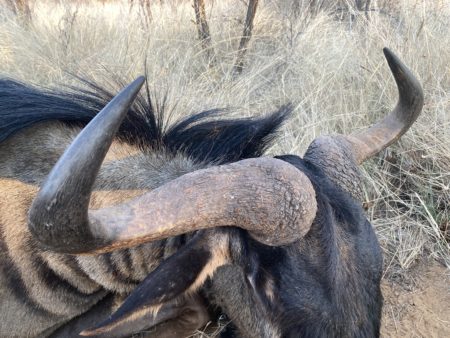
Blue Wildebeest 400 yards- These animals are the true athletes of Africa. They can run for miles without stopping. They heard together and run in circles to raise a cloud of dust to cover their escape path.

It was at Hunters Hill that I first saw these amazing beasts. But it was on Tommy’s farm Thandeka, that I harvested my first wildebeest.

Tommy’s ranch is located in Limpopo near the Botswana boarder on the edge of the Kalahari Desert. The old bull had parted from the his heard. He was hanging around some impala when I first saw him. His body was large and his horns impressive. He was a skittish creature, cautious in how it moved though the bush veld. Its judgement bering years of wisdom of its age.
It would be 3 days later when I would see him again. My PH Barry saw the bull as he inched out of the thick bush veld.

Feeling safe because he was 400 yards away. he looked straight at me, frozen still. hoping that he would not be seen. From a braced position, I fired a shot that struck him high on the shoulder. It was a double lung shot! He still ran 400 yards away before we found him expired in the tall grass.
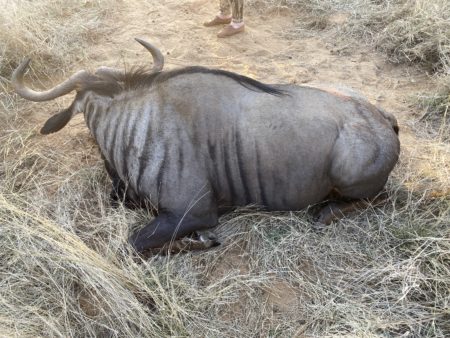
Truly a tenacious animal. The wildebeest back-straps, were the best game meat I enjoyed in Africa.

Kudu 200 yards- The grey ghosts of Africa. For Americans the Kudu is much like the North American Elk. Not in its looks but in its elusive nature. These animals are very light footed for their size. They live in the mountains and travel many miles every day in search of green grass. They are some of the most sought after game animals in Africa by American hunters. They taste delicious but they are also an amazing game animals to hunt.

They live in beautiful habitats, they travel in small herds and they are cleaver. In the picture above, you see my PH Jason and Master Tracker Lucas glassing the valley looking for Kudu. The grass is about 750 yards from our vantage point. A challenging potential shot but very plausible with a 300 Weatherby.

It took me 7 days and hundreds of miles to find my trophy bull. We traveled to different ranches in search of my trophy Kudu. We saw Kudu every day at different distances. My Professional Hunter Jason wanted a bull that had ivory tips that pointed forward. This would insure that he was a mature bull. Since I was there for 21 days, we had the luxury of time and could afford to be picky.
During those first 7 days, the shot presentation ranged from 400 to 800 yards. So we traveled and we traveled to neighboring ranches in search for my grey ghost!
On the 8th day we traveled to Comre, a ranch located 2 hours from Hunters Hill. We saw Kudu on the 1st night there, but at last light it was hard to see the tips of the horns.

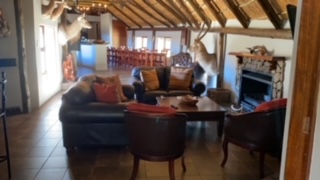
The next morning, the entire mountain side became alive. The mountain Zebra and Gemsbok could be seen feeding. Young Kudu cows and young bulls also came out to feed. Giraffes at the base of the hills with necks swaying from branch to branch.

In the morning be Brought out the spotting scope and we glassed the mountains looking for the ghosts. On a clear day you can see 200 miles in any direction.
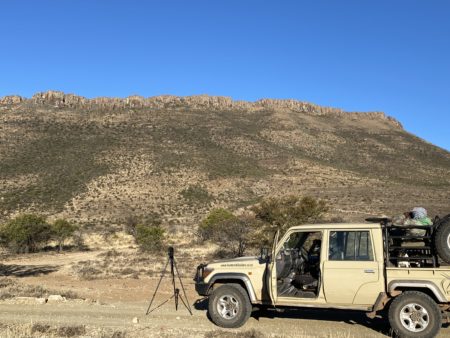
The marvel of Africas hypnotic beauty will stimulate your senses. The vastness of the valleys and the majesty of the mountains invigorates you to the core. At dawn you will realize that its a special place and the fellowship of the hunt as drawn you to travel 12,000 miles for the experience!

PH Jason drove the Land Cruiser to the back side of the mountain to a cliff overlooking a catch basin watering hole. That is were we bumped a small heard of Kudu. My trophy bull was in a small herd of seven. At 200 yards, the shot was not very far but it was a challenge. They were trotting away at a brisk pace maneuvering through thick trees. I only had a small window between the brush to take a shot.

It took 3 shots to close the deal and harvest my amazing trophy bull Kudu. The first shot slowed him down, the second shot anchored him and the 3rd shot, lights out! We enjoyed him for dinner 2 nights later. The rest of the animal was shared with the camp staff and their family.
(It should be duly noted that no part of these animals went to waste. Any remaining meat was sold in local market as legal game meat. The trimmings and parts not fit for human consumption was fed to the resident lion pride held as pets of the land owner.)

**Kudu Tongue with a sweet mustard sauce!
In conclusion
Overall the 300 Weatherby deserves the reputation that it has garnered over the years. Not surprisingly, the 300 Weatherby is Weatherby’s most popular caliber. I enjoy shooting it and have come to love its performance on large bodied game animals. My Weatherby is now “Africa certified” and ready for our next hunting adventure!

Hunters are adventures. They travel to distant lands in search of adventure with a passion for wild things and the wild places they live.

I want to thank my good friend “Empty Clip” for taking the leap of faith and trusting me with the planning of our African adventure. It was a blast and changed the way we see the world of hunting and camaraderie among hunters/friends! It was 100%!
Langosta- 45
Copyrights reserved 2021